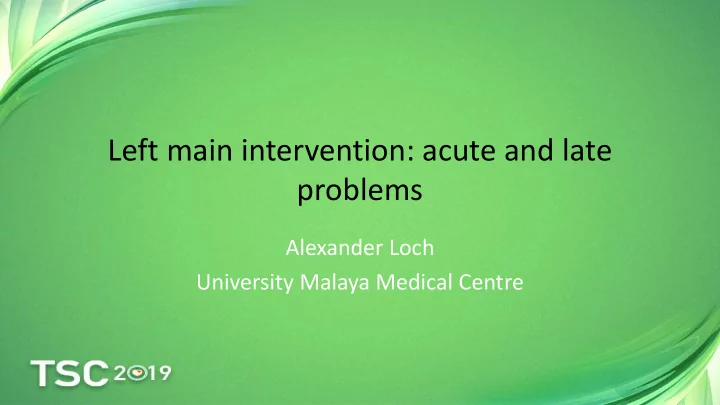

Left main intervention: acute and late problems Alexander Loch University Malaya Medical Centre
Case 1. Acute problem
Presentation • 54yo male • AMI • ST elevation lateral leads • History of multiple PCIs
Diagnostics
What to do? Issues: late presentation LCX likely infarcted…. Any benefit opening LCX? PCI to LCX will jeopardize flow to LAD…. Likely messy… Options: 1. Leave it as it is? 2. Stent LAD as prognostically more important 3. Try to open LCX and be prepared for bifurcation stenting
What to do? Issues: late presentation LCX likely infarcted…. Any benefit opening LCX? PCI to LCX will jeopardize flow to LAD…. Likely messy… Options: 1. Leave it as it is? 2. Stent LAD as prognostically more important 3. Try to open LCX and be prepared for bifurcation stenting
Onyx 3.0 x 12 LMS LCX Runthrough into LCX POBA Trek 2.75 x 15
Biofreedom 3.0 xx 33 LMS LAD (Culotte)
Biomatrix 2.72 x 28 (prox LAD) Biomatrix 2.5 x 33 (mid-distal LAD)
Result Culotte LMS prior to FKB
FKB (Lacrosse 2.5x15 LAD / Trek 2.0x15 LCX)
Biomatrix Neoflex 3.5 8 in LMS Lacrosse 2.5 x 15 LAD and LCX
Accepted result
Lessons Case 1: Dissection LMS after FKB • Keep it simple • FKB can result in LMS dissection • Immediate diagnosis and remedial is key
Case 2. Acute and late problem
Presentation • 71 yo lady • Severe angina • Rejected CABG • For provisional LMS LAD
Scoreflex 2.75x15 LAD Ultimaster 3.0 x 24 in prox LAD Ultimaster 3.5 x 18 from LMS LAD
Plaque shift into oLCX
Reverse crush LCX LAD NC Trek 3.75 x 15 (LAD) / Ultimaster 3.0 12 (LCX) FKB (NC Euphoria 2.5 x 15 / 3.0 x 15) POT (Accuforce 4.0 x 8)
Final result
Happy?!
6 months later angina…
Sapphire NC 4.0 x 10 Re-wiring and IVUS. POBA / DEB LCX Biomatrix alpha 3.5 x 29
Lessons Case 3: Reverse crush for LCX compromise resulting in ISR • Expect SB occlusion - even if ostium not (very) diseased • Reverse crush is bailout option if size discrepancy branches • Crush leaves a lot of metal • High index suspicion for ISR (despite FKB, POT….) • Correction – simple provisional stent … so far so good
Case 3. Acute problem
Background • Pt with oLMS and RCA disease
Diagnostic images
Background • Attempted PCI LMS at another centre (no image record): – Pt developed bradycardia and APO when wiring LAD – Procedure abandoned – Referred for CABG – CTS declined as considered “too high risk” • For elective PCI oLMS
JL3.5 7F, IABP 34cc, venous sheath Runthrough : wiring from outside
POBA oLMS (Tazuna 2.5 x12) POBA oLMS (NSE Alpha 4.0 x 13)
Stent placement oLMS (Promus Premier 3.0 x 32) Stent inflation (Promus Premier 3.0 x 32) NC balloon oLMS (Accuforce 4.0 x 8)
Final result
Lessons Case 4: oLMS unprepared PCI attempt resulting in bradycardia /APO • Preparation is key • Tight ostial lesions: – IABP – Pacing sheath standby – Wiring from outside – do not engage guide – Fast inflations
Case 4. Late problem
• 47yo man • Textbook DK crush LMS bifurcation under IVUS – LAD Xience 4.0 x 23, – LCX Xience 4.0 x 18, – FKB 3.5 x15 NC trek in both LAD and LCX, – POT 5.0mm balloon
DK crush result
• Presents 16 months later with exertional chest pain
Diagnostic images
Volcano IVUS LCX : fully expanded stent, ISR and clot +++ at ostium Thrombuster 6F clot aspiration Euphora 3.5x 15 LMS LCX followed by Accuforce 4.0 x 15
Volcano IVUS LCX : fully expanded stent, clot +++ at ostium Thrombuster 6F clot aspiration Euphora 3.5x 15 LMS LCX followed by Accuforce 4.0 x 15 Clot spill over into LAD ostium after ballooning LCX
IVUS LAD: fully expanded stent, some clots Sequent please DEB 4.0 x 20 into LCX Euphora 3.5x 15 LMS LAD followed by Accuforce 4.0 x 15
Final result
Lessons Case 5: ISR after DK crush • Even “ideal” bifurcation stenting (DK Crush/IVUS guided) can develop early significant ISR • Low threshold for relook • Simple POBA will often do the job
Literature
• Registry data • 1,353 patients • early-generation drug-eluting stent (E-DES) • Contemporary drug-eluting stent (C-DES) • Primary endpoint MACE (composite of cardiac death or myocardial infarction, stent thrombosis, target lesion revascularization) • 3-year follow-up
• early clinical outcomes – provisional and planned 2-stent treatment strategies similar outcome • long-term follow-up ( 3 years) – rates of cardiac death, MI, and TLR more common with planned 2-stent (14.4% vs 21.2%, adjusted [HR] 0.51) • Strong benefit toward the 1-stent strategy
• At 3 years, MACE occurred in 49 patients the culotte group and in 17 patients in the DK crush group (cumulative event rates of 23.7% and 8.2%, respectively; p < 0.001),
• TLF within 1 year – in 26 patients (10.7%) assigned to PS – in 12 patients (5.0%) assigned to DK crush (hazard ratio: 0.42) true distal LM bifurcation lesions using a planned DK crush 2-stent strategy resulted in a lower rate of TLF at 1 year than a PS strategy
Overall summary • Acute complications include • arterial dissection • arrhythmias • acute vessel closures • Late complications include: • ISR and ST
Recommend
More recommend